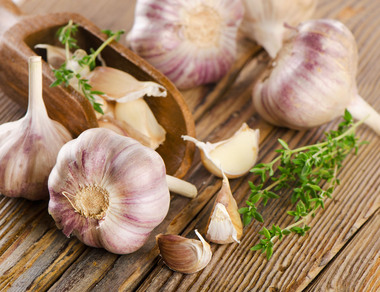
Garlic is one of the oldest cultivated plants in the world and has been cultivated for over 5000 years. For just as long, the bulb has also been traditionally used in naturopathy, especially for challenges to the well-being of respiratory, intestinal and skin function and to support the cardiovascular system. And garlic also helps against vampires when in doubt.
The Nile Delta near Giza, about 4600 years ago: The sun burns relentlessly, shade is not to be found and the work is hard. For the Pharaoh Cheops has commissioned a pyramid as his future tomb - it is to be the highest in the world! The ancient Egyptian king makes demands: he calls his pyramid "Achet Chufu", which means "Horizon of Cheops". Today it is better known as the Pyramid of Cheops. It is counted among the Seven Wonders of the Ancient World; together with the neighbouring pyramids of the pharaohs Khafre and Mykerinos, it is the only one of these "wonders of the world" that has survived to the present day. Cheops did not choose the royal necropolis of Dahshur as the building site for his project, like his predecessor Snofru, but the Giza plateau.
To build the pyramid, a total of about 2.5 million stone blocks are used, which have to be produced from the limestone of the region. The minimum weight is 2.5 tonnes per block; pure muscle and willpower (and fear of punishment) drive the men. And something else gives the men energy for this almost fantastic construction project, which is one of only three of the Seven Wonders of the Ancient World to have survived to this day. The Ancient Egyptians used garlic as an ancient healing bulb, giving the pyramid workers stamina and strength!
Garlic is also traditionally used in naturopathy
And so it is not surprising that archaeologists found garlic in the tombs of the ancient Egyptian pharaohs, in addition to objects such as furniture, games, storage vessels, jewellery, fruit baskets, meat, wine jars, gold, precious stones, weapons, musical instruments and writing implements. The bulb is one of the oldest cultivated plants in the world and has been cultivated for over 5000 years. For just as long, garlic has also been traditionally used in naturopathy, especially for challenges to the well-being of respiratory, intestinal and skin function. However, it was and is also said to have a positive effect on the blood and its flowability in particular, which is why garlic was and is traditionally used to support the cardiovascular system.
The ancient Egyptians were probably the first to cultivate garlic on a large scale, as it played an important role in their culture and religion. One example: fresh garlic cloves were peeled, crushed and soaked in a mixture of vinegar and water along the Nile. The decoction was used as a rinse against sore throats and toothaches - after all, the pharaohs were not supposed to have a sore throat or toothache on their last journey!
In Central and South-East Asia, where garlic was originally native before it made its triumphal march from there via Egypt to Europe, garlic was and is an indispensable part of the daily diet, as the Asians discovered the special powers and effects of garlic early on and made them their own. The ancient Greeks and Romans also knew garlic as a source of energy. Athletes ate it before competitions, soldiers before battle. And the Roman emperors couldn't get enough of it - garlic was considered an effective antidote. For the risk of being killed by a poison attack was not exactly small.
Positive effect of garlic on the cardiovascular system
For strength in pyramid building and against poison attacks, garlic is hardly used today. Instead, the healthy tuber is also experiencing a boom in modern medicine. It was not without reason that garlic was even included in the "German Pharmacopoeia" in 1998, after its effects had been tested and confirmed in comprehensive studies. The background to this was, among other things, that scientific research had shown that mainly in the regions where garlic is virtually part of the daily staple diet, there were fewer challenges to the cardiovascular system in the local population than in other countries, mainly in the so-called "western world". It was also investigated whether and to what extent the regular consumption of garlic has an effect on life expectancy or not.
The Techniker Krankenkasse states: "Garlic contains various sulphur components, but its main ingredient is a volatile oil, allicin. This oil regulates blood clotting, prevents the blood from thickening and dissolves already existing clots. In addition, garlic reduces cholesterol production in the liver and at the same time causes cholesterol to be broken down more. This makes garlic a supportive remedy for people who suffer from high blood pressure, are at risk of thrombosis or have heart and circulation problems. The active ingredient allicin also has a strong antibacterial and fungicidal effect."
The positive effect of garlic on the cardiovascular system has also been proven in recent studies. For example, garlic reduces the amount of blood fats, which are known to be linked to high blood pressure, the number one common disease. Fewer blood fats mean that the blood can flow better and the risk of arteriosclerosis is reduced. Cholesterol levels can also be lowered significantly through regular garlic consumption. It has been proven that the sulphides in garlic reduce cholesterol and triglyceride levels in the blood - in other words, blood fat levels. This also reduces the risk of the dreaded hardening of the arteries.
Aomori garlic with positive properties without odour nuisance
Aomori garlic, which is prepared according to an old Japanese tradition, is very popular today as a food supplement, especially as an extract. This special garlic is subjected to a so-called natural fermentation process. This special way of preparation is said to be an essential point for the effect of the new product. The healthy ingredients of garlic are practically enclosed in its cells - every single plant cell has to be broken open to get to these treasures. This means hard work for our intestines and often only a fraction of the healthy garlic substances reach the organism - most of it is excreted undigested, it is virtually given away.
This is why Aomori garlic is gently stored in pure seawater for 40 days, which gently breaks down the plant cells. This makes the bioavailability of all ingredients particularly high. Bioavailability indicates how quickly and to what extent the substance is absorbed and available at the site of action - in the case of Aomori garlic, this is the entire cardiovascular system. This rapid improvement in blood circulation increases the ability to perform and concentrate.
The positive properties come about without any unpleasant smell. The natural fermentation and a special processing method of Aomori garlic minimise the unpleasant odour-forming substances of the tuber. This means that users of this natural product can support their bodies with the power of Aomori garlic without getting weird looks and wrinkled noses from friends, colleagues and family.
By the way: Do you believe in ghosts and vampires? Then you can also use garlic. The bulb is known as a weapon against vampires. We know this from the world-famous novel "Dracula" by the English writer Bram Stoker. In his 1897 novel, the motif of garlic as a Transylvanian household remedy against vampires appears repeatedly, for example in the form of a ruff made of garlic flowers. And further: "I will cut off her head, fill her mouth with garlic and then drive a stake through her body," says vampire hunter Professor van Helsing about the planned treatment of the delicate Lucy Westenra, who has been turned into an undead bloodsucker by Dracula. Incidentally, Stoker got his idea of keeping vampires at bay by means of a garlic necklace from the German theologian Johann Christoph Harenberg. In 1733, he wrote the book "Vernünftige und Christliche Gedancken über die Vampirs" (Reasonable and Christian Thoughts on Vampires), in which he first gave the tip about garlic.
* This text may contain translation errors as the translation was performed by an online translation tool.










